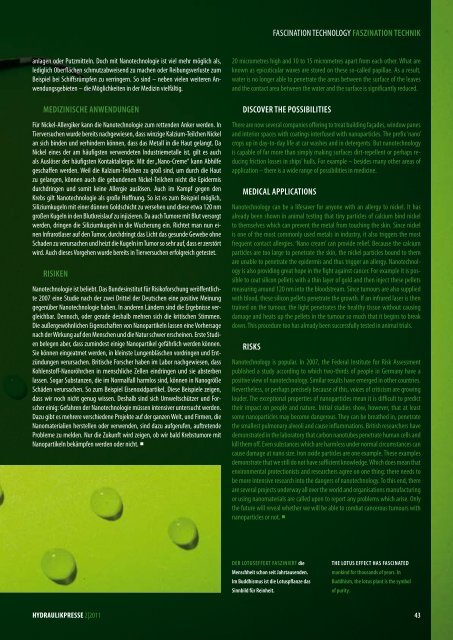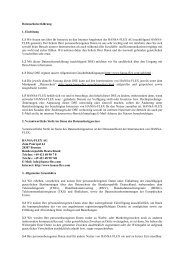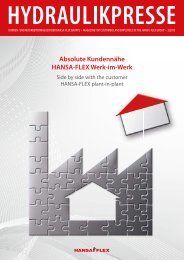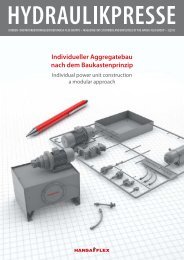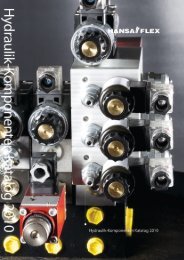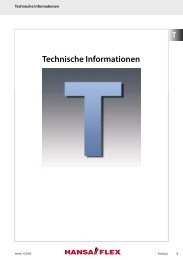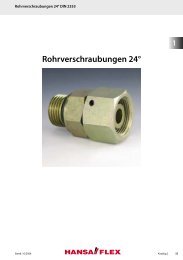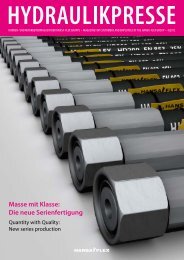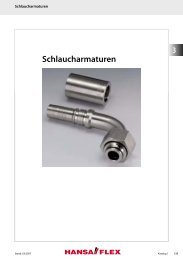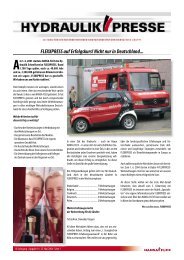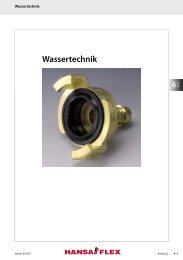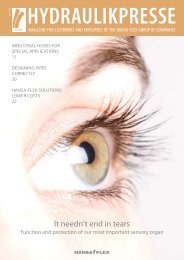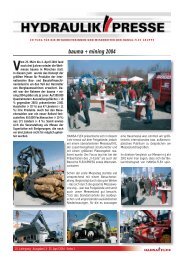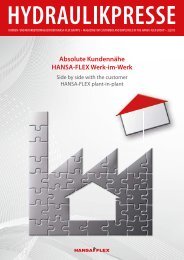Hydraulikpresse 2 | 2011 - Hansa Flex
Hydraulikpresse 2 | 2011 - Hansa Flex
Hydraulikpresse 2 | 2011 - Hansa Flex
Sie wollen auch ein ePaper? Erhöhen Sie die Reichweite Ihrer Titel.
YUMPU macht aus Druck-PDFs automatisch weboptimierte ePaper, die Google liebt.
anlagen oder putzmitteln. doch mit nanotechnologie ist viel mehr möglich als,<br />
lediglich oberflächen schmutzabweisend zu machen oder reibungsverluste zum<br />
beispiel bei schiffsrümpfen zu verringern. so sind – neben vielen weiteren anwendungsgebieten<br />
– die Möglichkeiten in der Medizin vielfältig.<br />
mediZiniscHe anwendunGen<br />
für nickel-allergiker kann die nanotechnologie zum rettenden anker werden. in<br />
tierversuchen wurde bereits nachgewiesen, dass winzige Kalzium-teilchen nickel<br />
an sich binden und verhindern können, dass das Metall in die haut gelangt. da<br />
nickel eines der am häufigsten verwendeten industriemetalle ist, gilt es auch<br />
als auslöser der häufigsten Kontaktallergie. Mit der „nano-creme“ kann abhilfe<br />
geschaffen werden. Weil die Kalzium-teilchen zu groß sind, um durch die haut<br />
zu gelangen, können auch die gebundenen nickel-teilchen nicht die epidermis<br />
durchdringen und somit keine allergie auslösen. auch im Kampf gegen den<br />
Krebs gilt nanotechnologie als große hoffnung. so ist es zum beispiel möglich,<br />
siliziumkugeln mit einer dünnen goldschicht zu versehen und diese etwa 120 nm<br />
großen Kugeln in den blutkreislauf zu injizieren. da auch tumore mit blut versorgt<br />
werden, dringen die siliziumkugeln in die Wucherung ein. richtet man nun einen<br />
infrarotlaser auf den tumor, durchdringt das Licht das gesunde gewebe ohne<br />
schaden zu verursachen und heizt die Kugeln im tumor so sehr auf, dass er zerstört<br />
wird. auch dieses vorgehen wurde bereits in tierversuchen erfolgreich getestet.<br />
risiken<br />
nanotechnologie ist beliebt. das bundesinstitut für risikoforschung veröffentlichte<br />
2007 eine Studie nach der zwei Drittel der Deutschen eine positive Meinung<br />
gegenüber nanotechnologie haben. in anderen Ländern sind die ergebnisse vergleichbar.<br />
dennoch, oder gerade deshalb mehren sich die kritischen stimmen.<br />
die außergewöhnlichen eigenschaften von nanopartikeln lassen eine vorhersage<br />
nach der Wirkung auf den Menschen und die natur schwer erscheinen. erste studien<br />
belegen aber, dass zumindest einige nanopartikel gefährlich werden können.<br />
sie können eingeatmet werden, in kleinste Lungenbläschen vordringen und entzündungen<br />
verursachen. britische forscher haben im Labor nachgewiesen, dass<br />
Kohlenstoff-nanoröhrchen in menschliche Zellen eindringen und sie absterben<br />
lassen. sogar substanzen, die im normalfall harmlos sind, können in nanogröße<br />
schäden verursachen. so zum beispiel eisenoxidpartikel. diese beispiele zeigen,<br />
dass wir noch nicht genug wissen. deshalb sind sich umweltschützer und forscher<br />
einig: gefahren der nanotechnologie müssen intensiver untersucht werden.<br />
dazu gibt es mehrere verschiedene projekte auf der ganzen Welt, und firmen, die<br />
nanomaterialien herstellen oder verwenden, sind dazu aufgerufen, auftretende<br />
probleme zu melden. nur die Zukunft wird zeigen, ob wir bald Krebstumore mit<br />
nanopartikeln bekämpfen werden oder nicht. ¡<br />
HYDRAULIKPRESSE 2|<strong>2011</strong><br />
fascination technoLogy FasZinaTion TecHnik<br />
20 micrometres high and 10 to 15 micrometres apart from each other. What are<br />
known as epicuticular waxes are stored on these so-called papillae. as a result,<br />
water is no longer able to penetrate the areas between the surface of the leaves<br />
and the contact area between the water and the surface is significantly reduced.<br />
discover THe possiBiliTies<br />
there are now several companies offering to treat building façades, window panes<br />
and interior spaces with coatings interfused with nanoparticles. the prefix ‘nano’<br />
crops up in day-to-day life at car washes and in detergents. but nanotechnology<br />
is capable of far more than simply making surfaces dirt-repellent or perhaps reducing<br />
friction losses in ships’ hulls. for example – besides many other areas of<br />
application – there is a wide range of possibilities in medicine.<br />
medical applicaTions<br />
nanotechnology can be a lifesaver for anyone with an allergy to nickel. it has<br />
already been shown in animal testing that tiny particles of calcium bind nickel<br />
to themselves which can prevent the metal from touching the skin. since nickel<br />
is one of the most commonly used metals in industry, it also triggers the most<br />
frequent contact allergies. ‘nano cream’ can provide relief. because the calcium<br />
particles are too large to penetrate the skin, the nickel particles bound to them<br />
are unable to penetrate the epidermis and thus trigger an allergy. nanotechnology<br />
is also providing great hope in the fight against cancer. for example it is possible<br />
to coat silicon pellets with a thin layer of gold and then inject these pellets<br />
measuring around 120 nm into the bloodstream. since tumours are also supplied<br />
with blood, these silicon pellets penetrate the growth. if an infrared laser is then<br />
trained on the tumour, the light penetrates the healthy tissue without causing<br />
damage and heats up the pellets in the tumour so much that it begins to break<br />
down. this procedure too has already been successfully tested in animal trials.<br />
risks<br />
Nanotechnology is popular. In 2007, the Federal Institute for Risk Assessment<br />
published a study according to which two-thirds of people in germany have a<br />
positive view of nanotechnology. similar results have emerged in other countries.<br />
nevertheless, or perhaps precisely because of this, voices of criticism are growing<br />
louder. the exceptional properties of nanoparticles mean it is difficult to predict<br />
their impact on people and nature. initial studies show, however, that at least<br />
some nanoparticles may become dangerous. they can be breathed in, penetrate<br />
the smallest pulmonary alveoli and cause inflammations. british researchers have<br />
demonstrated in the laboratory that carbon nanotubes penetrate human cells and<br />
kill them off. even substances which are harmless under normal circumstances can<br />
cause damage at nano size. iron oxide particles are one example. these examples<br />
demonstrate that we still do not have sufficient knowledge. Which does mean that<br />
environmental protectionists and researchers agree on one thing: there needs to<br />
be more intensive research into the dangers of nanotechnology. to this end, there<br />
are several projects underway all over the world and organisations manufacturing<br />
or using nanomaterials are called upon to report any problems which arise. only<br />
the future will reveal whether we will be able to combat cancerous tumours with<br />
nanoparticles or not. ¡<br />
der loTuseFFekT FasZinierT die<br />
menschheit schon seit Jahrtausenden.<br />
im Buddhismus ist die lotuspfl anze das<br />
sinnbild für reinheit.<br />
THe loTus eFFecT Has FascinaTed<br />
mankind for thousands of years. in<br />
Buddhism, the lotus plant is the symbol<br />
of purity.<br />
43


